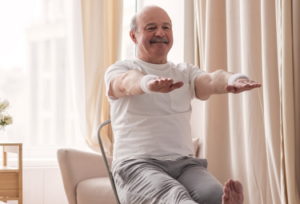Exercising With Chronic Conditions
August 19, 2024
Almost anyone, at any age, can do some type of physical activity. You can still exercise even if you have a health condition like heart disease, arthritis, chronic pain, high blood pressure, or diabetes. In fact, physical activity may help. For most older adults, physical activities like brisk walking, riding a bike, swimming, weightlifting, and gardening are safe, especially if you build up slowly. You may want to talk with your doctor about how your health condition might affect your ability to be active.
Staying physically active: Alzheimer’s disease and related dementias
Researchers are assessing the benefit of exercise to delay mild cognitive impairment (MCI) in older adults and to improve brain function in older adults who may be at risk for developing Alzheimer’s disease. Older adults with MCI may be able to safely do more vigorous forms of exercise, similar to older adults without MCI, provided there are no other underlying health concerns.
Being active and getting exercise may help people with Alzheimer’s or another dementia feel better and can help them maintain a healthy weight and have regular toilet and sleep habits. If you are a caregiver, you can exercise together to make it more fun.
Exercising with arthritis
For people with arthritis, exercise can reduce joint pain and stiffness. It can also help with losing weight, which reduces stress on the joints.
Flexibility exercises such as upper- and lower-body stretching and tai chi can help keep joints moving, relieve stiffness, and give you more freedom of movement for everyday activities.
Strengthening exercises, such as overhead arm raises, will help you maintain or add to your muscle strength to support and protect your joints.
Endurance exercises make the heart and arteries healthier and may lessen swelling in some joints. Try activities that don’t require a lot of weight on your joints, such as swimming and biking.
If you have arthritis, you may need to avoid some types of activity when joints are swollen or inflamed. If you have pain in a specific joint area, for example, you may need to focus on another area for a day or two.
Physical activity and COPD (Chronic Obstructive Pulmonary Disease)
If you have COPD, talk with your healthcare provider or a pulmonary therapist to learn what he or she recommends. You may be able to learn some exercises to help your arms and legs get stronger and/or breathing exercises that strengthen the muscles needed for breathing.
Pulmonary rehabilitation is a program that helps you learn to exercise and manage your disease with physical activity and counseling. It can help you stay active and carry out your day-to-day tasks.
Exercising with type 2 diabetes
For people with diabetes, exercise and physical activity can help manage the disease and help you stay healthy longer. Walking and other forms of daily exercise can help improve glucose levels in older people with diabetes. Set a goal to be more active most days of the week, and create a plan for being physically active that fits into your life and that you can follow. Your healthcare team can help.
A few easy steps to be more active:
- Stretch during TV commercial breaks.
- Walk around when you talk on the phone.
- Take more steps by parking farther away from stores, movie theaters, or your office.
Exercise and heart health
Your heart keeps your body running. As you grow older, some changes in the heart and blood vessels are normal, but others are caused by disease. Choices you might make every day, such as eating healthy, maintaining a healthy weight, and aiming to be more physically active, can contribute to heart health. Inactive people are nearly twice as likely to develop heart disease as those who are active. A lack of physical activity can worsen other heart disease risk factors as well, such as high blood cholesterol and triglyceride levels, high blood pressure, diabetes and prediabetes, and overweight and obesity. Being physically active is one of the most important things you can do to keep your heart healthy. Aim for at least 150 minutes of moderate-intensity aerobic activity a week.
Exercising with osteoporosis
Weight-bearing exercises, which force you to work against gravity, such as walking, jogging, or dancing three to four times a week, are best for building muscle and strengthening bones. Try some strengthening and balance exercises, too, to help avoid falls, which could cause a broken bone. Doing these exercises is good for bone health for people with osteoporosis and those who want to prevent it.
Exercising with chronic pain
Most people living with chronic pain can exercise safely, and it can assist with pain management. In fact, being inactive can sometimes lead to a cycle of more pain and loss of function. Talk to your doctor about what exercises/activities might be right for you. Each type of exercise—endurance, strength, balance, and flexibility—has its own benefits, so a combination may be best.
Exercise can help you maintain a healthy body weight, which may relieve knee or hip pain. Putting on extra weight can slow healing and make some pain worse. Remember to listen to your body when exercising and participating in physical activities. Avoid over-exercising on “good days.” If you have pain, swelling, or inflammation in a specific joint area, you may need to focus on another area for a day or two. If something doesn’t feel right or hurts, seek medical advice right away.
Quick tip
Pain rarely goes away overnight. Talk with your doctor about how long it may take before you feel better. As your pain lessens, you can likely become even more active.
To learn more, please visit https://www.nia.nih.gov/health/exercise-and-physical-activity/exercising-chronic-conditions.